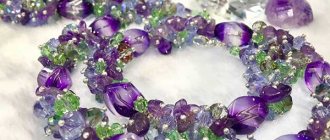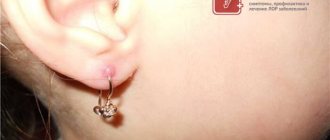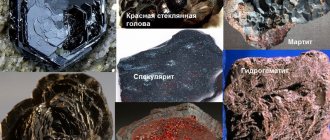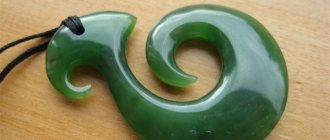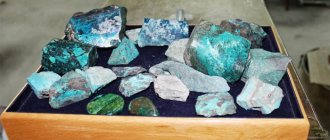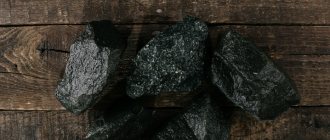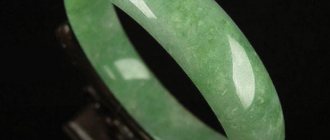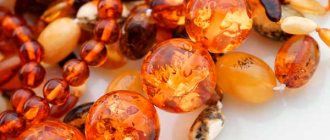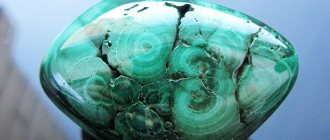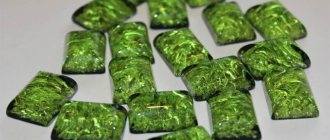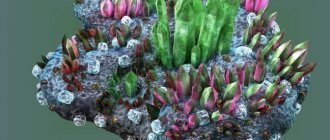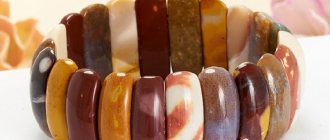A little history
In Europe, serpentinite stone was first discovered in the 16th century. First of all, it was of interest to craftsmen as a finishing and ornamental material. Tabletops, dishes, watches were made from it, and weapons were decorated with it. At a low cost, it had a spectacular appearance. Such luxury was available to anyone from aristocrats to ordinary citizens. Later, pharmacists began to actively use the stone to make mortars, pestles and other devices. Occultists discovered powerful magical properties in it.
Based on the results of archaeological excavations, it became clear that Europeans were not the discoverers of serpentinite. Talismans and jewelry with stones were found in the tombs of the Mayan and Incas. Serpentinite has also been popular in the East since time immemorial. The fact is that this stone is very similar to jade and jadeite, which only rulers and nobility could wear. And jewelry with a coil was available to everyone.
History of the serpentine
The modern name for the stone is serpentinite, although most people still know it as serpentine.
“Serpent” means “snake” in Latin: the color of the stone resembles snake skin, hence the name “serpentine”. And its history is shrouded in legends. Advertising - Continued below
According to one of them, it is believed that the serpentine is the fossilized skin of the fiery serpent - the Great Snake, which guarded the entrance to the cave with gold. Anyone who finds a coil in the mountains will certainly find a treasure.
Another legend says that Adam, tempted by the persuasion of the Tempting Serpent and tasting an apple from the Tree of Knowledge, choked and spat out the piece on the ground. He turned into stone, which turned out to be serpentine. It is because of this that some consider the serpentine stone to be a stone of knowledge, while others talk about it as a dangerous mineral that can cause trouble.
Polished serpentine stones. Photo: lana73.livemaster.ru
The stone has one incredible property: with special processing, it splits into elastic fibers, like threads. It is known that fire-resistant fabric was woven from such threads back in the time of Peter I. Nikita Demidov (1656−1725), a famous gunsmith, demonstrated fire-resistant stone fiber in action by throwing it into the fireplace and getting it out unharmed, which greatly surprised the Russian Tsar .
Advertising - Continued below
Characteristics of the stone
Serpentinite is a dense rock interspersed with fine crystalline fibers, which is formed as a result of igneous metamorphism, which is characterized by a high magnesium content. The composition is represented by the following main substances:
- minerals of the serpentine group;
- carbonates;
- grenades;
- olivines;
- pyroxenes;
- amphiboles;
- talc;
- magnetites;
- chromites;
- and so on.
The stone has a smooth surface and massive texture. The surface is rough, but can be polished well and has a mirror shine. Despite its apparent strength, the hardness on the Moss scale is only 4, and therefore the pebble is susceptible to damage.
Large deposits of serpentine are found in the western United States, Great Britain, Germany, Switzerland and Poland. One of the leaders in serpentinite mining is Russia. The largest deposits are developed in the Caucasus and the Urals. It is quite simple to extract the serpentine, because it lies in large layers. This determines the relatively low cost of the stone.
Varieties and colors
The serpentine mineral has a range of green tones - from olive to very dark. If there is a pattern, it looks like veins or spots.
There are many varieties of serpentine in nature, the three main ones are:
- Attigorite is a yellow or green agglomerate with a glassy or matte sheen.
- Chrysotile is a translucent mineral with a silky shine; color green, whitish-green, white or golden; can easily be divided into flexible thin fibers. Colloquially known as asbestos.
- Lizardine is green, greenish-blue, dark green, white or yellow. The gloss is matte and greasy. It shines through at the edges.
Other varieties include:
- Bowenite (tangevaite) is a pale green mineral, sometimes with a yellow or blue tint. Externally it resembles jade. It differs from other types in its high hardness.
- Verdanite - the background of the stone is swamp green, with dark veins on it.
- Vernantite is dark green with shiny calcite veins.
- Williamsite is a green specimen with a blue tint and a small number of small black spots. Tones can be both dark and light.
- Nigrescite is an example of the darkest color - from deep green to almost black.
- Retinolite - green and sand tones, resinous shine.
- Ricolite is bright green, sometimes pale yellow or gray with clear stripes.
Other serpentine minerals are rare in nature.
Noble types of coils, distinguished by a beautiful pattern, silky shine, and glow, include:
- Ophite (noble serpentine) is a slightly translucent stone without dark inclusions, with a uniform green color. Can be confused with jade, but ophite is twice as soft.
- Noble serpentine (in the Urals called moss fly) - with an even light olive or pale light green color; Sometimes there are small dark inclusions.
These two varieties are used as ornamental stone.
Varieties
Depending on the chemical composition of serpentinite and the presence of certain impurities in it, there are several types of stones that differ in color, texture and pattern. Here are some of them:
- Verdantite is dark green with silver veins.
- Bowenite is pale green, slightly translucent.
- Williamsite is green-blue, slightly shimmering like a cat's eye.
- Ophicalcite (serpentinite marble) - has characteristic spots and streaks reminiscent of a marble surface.
- Noble serpentine - yellow-green or white-green with black specks. May show through on thin chips.
- Ricolite is yellow-green with a striped pattern.
- Retinolite - honey yellow. Has an attractive resinous luster.
Physical properties
Optical
The color is yellow-green, dark green in thin fragments, bottle green of various shades to greenish-black, sometimes brownish-green. Often variegated in color (like the skin of a snake). Ophyte is often a pale olive green with a yellow tint. Antigorite is pale green, often gray, sometimes with a faint bluish tint.
In thin plates, colorless or green to brown.
The line is white.
Glass shine.
The cast is greasy, the ophite has a waxy, matte finish. The variety called bastite, which forms pseudomorphs after orthopyroxene (bronzite), is characterized by the preservation of a bronze tint.
Transparency. Transparent, translucent.
Refractive indices Refractive indices range between 1.55 and 1.80 (highest for iron rich). For antigorite pt = 1.55 1.58, for chrysotile pt = 1.54 1.55; the low refractive indices of the latter are due to a slightly higher water content and lower alumina content, which also explains its tubular shape. The birefringence of chrysotile (0.013) is slightly higher than that of antigorite (0.007). Most minerals are optically negative, only a few have a positive optical character (amesite, nepuite, chrysotile); 2V is about 50° for antigorite, 30° for chrysotile, other minerals are almost uniaxial.
Mechanical
The hardness of ordinary lizardite is 2.5–3, antigorite - up to 3.5, opite - 2.
Density 2.2 - 3.4. (kerolite, kronstedtite), 2.62 (antigorite), 2.36-2.50 (chrysotile).
Cleavage is observed only in larger lamellar varieties of antigorite: perfect along {001} and less perfect along {010}. Breakaway leaves..
The fracture ranges from smooth to conchoidal and splintered.
Chemical properties
Behavior in acids. Dissolves in hydrochloric and sulfuric acids.
Other properties: surfaces with shiny sliding mirrors are often observed.
Diagnostic signs
Similar minerals. Olivine, bronzite (bastite), garnet (pyrope), chlorites, chromite, magnetite, magnesite, opal, chalcedony, antigorite, tremolite-asbestos.
Macroscopically, serpentine masses are recognized relatively easily by their characteristic dark green shades, variegated color, dense glue-like masses, greasy shine, the presence of asbestos veins, often observed sliding mirrors, low hardness. Antigorite serpentinites have characteristic gray shades, exceptional viscosity, felt when processing samples with a hammer, higher hardness compared to conventional serpentinites.
Associated minerals. Olivine, hypersthene, hornblende, plagioclase, magnetite, calcite.
Scope of application
Serpentine is a very beautiful and versatile stone, and therefore its scope of application is quite wide. The stone is easy to cut and polish, and therefore it is used in the manufacture of jewelry. The original texture of the coil is a real find for carvers, who can create beautiful interior items and souvenirs from stone.
Serpentinite stone is also a popular finishing material. For baths, saunas, swimming pools, bathrooms, aquariums. This stone is even present in the design of some metro stations in the capital. Coil crumbs are used to effectively design garden paths.
Application
The coil is used in industry, jewelry, and arts and crafts.
Due to its high fire resistance, it is used in new technological developments, as well as in the creation of heat-resistant material (chrysolite-asbestos), from which equipment is made for workers in hot shops, employees of the Ministry of Emergency Situations and firefighters.
The crushed mineral is used in baths and placed in aquariums.
Decorative types are used for cladding panels, facades, fireplaces, and swimming pools.
Ornamental specimens - material for monuments, tabletops, watches, souvenirs, etc.
Jewelry is made from high-quality noble samples with patterns, shine, and glow.
Healing properties
The healing properties of serpentinite stone are highly valued by lithotherapists. Here's how a coil is useful:
- dulls headaches and eliminates dizziness;
- accelerates the healing of bone fractures;
- imparts vigor and vitality, fights chronic fatigue and loss of strength;
- supports normal functioning of the liver and spleen;
- normalizes the functioning of the gastrointestinal tract;
- fights stress and depression;
- promotes rapid recovery from colds;
- normalizes blood pressure;
- suppresses inflammatory processes in the body.
Several centuries ago, pharmacists and alchemists believed that serpentinite could enhance the healing properties of medicines, so they prepared them using mortars and pestles made from serpentine. Therefore, it would be wise to put a pebble in your home medicine cabinet.
Medicinal properties
It is not for nothing that the serpentine was called an apothecary stone - it is held in special esteem by folk healers and healers.
Official medicine recognizes that the effect of drugs is enhanced if these drugs are stored in a serpentine vessel. The dosage is reduced, but the effectiveness remains the same.
Modern healers use the serpentine as a healing agent, recognizing its following abilities:
- clears the room of bad energy;
- adds strength and endurance during physical, psychological, emotional overloads;
- reduces nervousness and excessive emotionality;
- removes waste and toxins from the body;
- has a beneficial effect on the immune system.
It is believed that the coil, starting to heat up, predicts the onset of illness.
Jewelry with serpentine is a therapeutic and prophylactic agent:
- Necklaces and beads are useful for gastrointestinal diseases and colds.
- Bracelets, rings - help with bruises, cuts, dislocations, fractures.
- Earrings are beneficial for hypertension, migraines, and headaches.
- Rosary beads have a beneficial effect on the nervous system.
The healing power is enhanced if the coil is set in cupronickel or silver.
Jewelry for healing
The healing properties of serpentinite stone can be revealed in different ways, depending on the type of jewelry it is set into:
- If you suffer from frequent headaches, high blood pressure and migraines, you should wear earrings with a coil. Decoration also prevents hearing loss.
- People suffering from increased bone fragility should wear bracelets and rings with serpentinite. Jewelry will protect you from fractures and dislocations, and will also speed up the healing of damaged tissue.
- Those who suffer from frequent colds, as well as bronchitis, tonsillitis and sinusitis are recommended to wear beads or pendants with a coil. And such decoration also has a beneficial effect on the functioning of the heart.
Please note that serpentinite is not suitable for constant wear. Wear jewelry two to three times a week or during periods of exacerbation of illnesses. With prolonged contact with the body, the coil can return accumulated negativity to a person.
Amulets, amulets and talismans.
This is one of the most powerful natural minerals, which is used to make magical security paraphernalia.
So what can a talisman, amulet or amulet made from a serpentine (ophite) do:
- Warns of the onset of illness. It will heat up.
- Protects against reptile attacks.
- Gives restraint and emotional stability.
- Cleanses the aura and energy.
- Helps develop physical activity and strengthen the body.
It will be very effective for representatives of such professions as lawyer, businessman and professional athlete. For them, this is a magical stimulant for achieving a goal. Excellent help for strong-willed and decisive people. The fourth feature on the list can be usefully used by public people.
IMPORTANT: The serpentine is a one-person stone. It cannot be worn after someone else. An exception is if a product made from this mineral fell into the hands of an inheritance or it was a sincere gift from the previous owner.
The production of amulets, talismans and amulets “disguised” as jewelry is quite common. They also have their purpose.
Earrings.
They help get rid of constant headaches, stabilize blood pressure and protect against bad thoughts.
Bracelets.
Prevent dislocations. Calm the nervous system and save from the evil eye and negativity.
Rings.
They protect against cuts and unfair indications of mistakes made.
Caskets.
Cleans and energizes the jewelry stored in it. Protects against theft and loss.
Compatible with other stones.
Serpentine harmonizes well in combination with other stones with the “heavy” energy of the earth element.
These include:
- Agate.
- Jet
- Nephritis.
- Lapis lazuli.
- Jasper.
- Onyx.
For men.
This is a stone of successful and persistent people. He endows men with willpower and intelligence. At the same time, he will not allow unnecessary stubbornness and perseverance to spoil favorable circumstances.
It is recommended to carry it in your pocket near your heart. This will help you make the right decision in any difficult life situation.
For women.
He endows the fair half of humanity with exceptional, seductive qualities. Makes you attractive.
It also develops natural intuition.
How to wear and care.
For the most part, esotericists adhere to the position that this gem is not recommended for constant wearing, especially on open areas of the body.
For a person who is depressed, wearing a product with this stone is strictly prohibited.
IMPORTANT: The stone absorbs negative energy. It must be cleaned in running water.
If the coil gets dirty, then just hold it in a soapy solution, then rinse thoroughly and put it on a cloth or paper napkin to dry.
Use when washing brushes is prohibited.
Who is the mineral not recommended for?
People with a soft character and weak willpower should not wear this stone. He will constantly experience them, practically creating various unpleasant situations in real life.
This stone is also contraindicated for people with addictions and bad habits. The serpentine is a temptation and temptation, so why allow yourself to be provoked.
Magic properties
The magical properties of serpentinite are few, but very significant. Here are the main ones:
- awakens the ability to clairvoyance and extrasensory perception;
- promotes self-development and self-realization;
- helps you find the right path in life;
- helps to recognize people's true intentions;
- protects from other people's negative energy and black magic.
From a magical point of view, serpentinite is a fairly strong stone, but it can also be dangerous. If its owner succumbs to bad thoughts and does something bad, the stone can severely punish him. We can talk about both banal everyday troubles and life-threatening situations. Therefore, you should not contact serpentinite on days when you are upset or angry with someone.
Physico-chemical characteristics
Like serpentine, the mineral opite is a magnesium silicate. This is the main component of the stone formula. Its composition and color may vary slightly due to the presence of other impurities.
Almost always the structure of the aggregates is fibers arranged in parallel or randomly. Formula: Mg 6[Si4O10](OH)8.
| Hardness (Mohs Scale) | 2,5-5,5 |
| Density | 2,40-2,80 |
| Refraction | 1,560-1,571 |
| Birefringence | Absent |
| Dispersion | Absent |
| Color | Green, yellow-green. |
| Transparency | Translucent to opaque. |
| Forms of selection | Dense, homogeneous mass. |
| singonia | Monoclinic. |
| Cleavage | Absent. |
| Kink | Conchoidal, splintered, jagged. |
| Birefringence | White. |
| Pleochroism | Absent. |
| Absorption spectrum lines | 464; 497. |
| Luminescence and Chelsea filter | Absent. |
| Characteristics | A variety of serpentine. Characteristic parallel-fiber and entangled crystalline aggregates. In fibrous aggregates, the fibers are flexible but not elastic. |
| Field | Russia (Ural, Siberia), Georgia (North Caucasus), Kazakhstan), Switzerland, USA, Sweden, Italy. |
| Shine | Silky. |
| Fragility | Fragile. |
The origin and basic physicochemical characteristics coincide with serpentine.
Who needs serpentinite
The powerful energy of serpentinite is useful in the following cases:
- If you have a stressful and exhausting job. The stone helps overcome physical fatigue and emotional burnout.
- If you lack courage and ambition. The stone awakens leadership qualities and stimulates activity.
- If you are engaged in self-education and self-development. The stone loves “self-taught people” and helps to comprehend new knowledge.
- If you often have to communicate with negative people. The stone takes on bad energy, protecting the owner.
Serpentinite and zodiac signs
Attractive photos of serpentinite inspire you to get some kind of decoration or souvenir made from this stone. But before you make a purchase, make sure that the stone suits your zodiac sign.
The serpentine is just the perfect talisman for Virgos and Capricorns. The stone affects representatives of these signs as follows:
- Gives vital energy and creative inspiration;
- brings good luck in all endeavors (both in personal life and in business);
- helps to avoid life's troubles;
- has a positive effect on overall well-being.
The stone also has a beneficial effect on representatives of the following zodiac signs:
- Aries - the stone makes a person more perspicacious and reasonable. Gives peace and inner harmony.
- Taurus is a stone that gives you the ability to see through people and subtly sense lies. It also makes a person more attractive to members of the opposite sex.
- Gemini - the stone makes a person more courageous and decisive. Helps you let go of past experiences and feel the energy of the future.
- Leo - a stone makes a person more active and persistent, suppresses the feeling of laziness. It also helps to achieve career success.
- Aquarius, Sagittarius, Scorpio - the stone gives a person courage and determination. Helps to reveal new abilities and realize the most daring plans.
Serpentine is contraindicated for people born under the signs of Pisces and Cancer. The stone spoils their character, making them deceitful, cunning and cunning. Perhaps at first these qualities bring certain benefits to a person, but later they cause a lot of trouble.
History of the stone
The mineral began to be actively used by humans in the 18th century, although it was discovered much earlier. Its peculiar design, reminiscent of a snake's color, and the translation of the name from Latin (“snake”) led to the spread of the erroneous opinion that serpentine and serpentine are one stone. In fact, these are two independent but related minerals belonging to the same class of serpentinites. They have identical properties, but differ in chemical composition. The main element in serpentine is magnesium, while the base element in serpentine is magnesium oxide.
How to distinguish an original from a fake
The green serpentinite ornamental stone is not very expensive, so it is very rarely counterfeited. Nevertheless, there are also those who try to pass off a tinted piece of plastic as a coil. Therefore, if you intend to buy jewelry or some kind of craft made from this stone, remember some signs by which the original can be distinguished from a fake:
- Try to estimate the weight of the stone. If it is very light, then it is a plastic fake.
- Look carefully at the color of the stone. If it is uniform, and the pattern is very “correct,” then this means that this is a fake. Chaotic stains, stripes and inclusions are visible on the surface of natural stone.
- Hold the stone in your palms for a couple of minutes. Real serpentinite will remain cold, while the fake will heat up.
- Squeeze the product tightly in your hand. A real stone should feel a slight tingling sensation.
Coil (serpentine) deposits
Pieces of natural serpentine.
Photo: gemsbymail.com Serpentine is classified as an ornamental stone and is not uncommon. It is mined on an industrial scale in India, Tajikistan, Azerbaijan, Kazakhstan, New Zealand, Great Britain and Italy.
In Russia, serpentine is mined in the Urals, Altai, Orenburg and Yakutsk regions.
Features of care
To ensure that the appearance and properties of serpentinite stone please you for as long as possible, it is important to follow some care rules. Namely:
- Products made from serpentinite are resistant to impacts and falls, since the stone is quite fragile.
- Store serpentinite jewelry separately from other items. Otherwise, it will quickly get scratched and lose its appearance.
- About once every six months the stone needs to be cleaned of dust and dirt. First you need to wash it in soapy water and then wrap it in a soft napkin so that it absorbs dirt.
In addition to dirt and dust, serpentinite tends to accumulate negative energy. Therefore, it is recommended to rinse it in a river or stream once every two to three months. If you don’t have a pond nearby, just rinse it at home with lightly salted water.
Types of serpentine stone
- noble serpentine (or ophite, serpophyte) - translucent with a muted green color. It resembles jade, which is sometimes replaced with ophite;
- ordinary serpentine - from opaque to translucent in green, often spotted colors;
- picrolite is a type of antigorite, also called satellite and Californian cat's eye for its similarity to it, which can be seen even from the photo;
- other types.
In addition to the serpentine mineral, there is also a rock called serpentinite (also known as serpentine).
These two concepts are often confused and confused. And it is not surprising, since they are interconnected: the coil consists mainly of serpentine.
The breed is distinguished by a wide variety of colors: green, yellow, red, blue, lilac-blue shades.
The stone also has its own classification:
- Williamsite – noble bright green serpentine;
- bowenite – fine-grained pale green, sometimes translucent;
- ricolite – distinguished by banding, has gray, yellow and green shades;
- Porcellophyte - resembles porcelain of an opaque green hue.
Serpentinite for baths
For Russian people, the bathhouse has a special meaning. Therefore, special attention is paid to its equipment and finishing. A good cladding for a bathhouse is serpentinite. The properties of this stone promote physical relaxation, establishing emotional balance, increasing potency, quickly treating colds and normalizing joint mobility. This is due to the fact that when water enters, the hot coil releases particles of magnesium and oxygen. The steam from serpentinite is quite soft, the room warms up quickly and evenly.
In addition to the healing properties of serpentinite stone for baths, people are also attracted by the low price. But keep in mind that serpentine is not the strongest stone. Under frequent exposure to a humid environment and high temperature, it quickly begins to lose the water bound inside it and gradually collapses, the lining has to be changed. Thus, if you plan to visit the bathhouse often, it is better not to save money and not use a coil. If you are determined to use serpentine, make sure that when purchasing the slabs there are no cracks or chips.
Even if you do not intend to use serpentinite for your bath, you should still take a closer look at its physical properties. The fact is that unscrupulous sellers often pass off cheap coils as rather expensive jadeite or jade. There is also a risk of acquiring basites and ultrabasites mined from serpentinized areas. In addition, the slabs may contain coil veins, which significantly deteriorates their quality. To recognize a deception, try scratching the slab or suspicious vein with a steel object. If a trace remains, it means you have serpentinite.
Application of serpentine, decoration and prices
The snake-colored mineral has been a unique material for making handicrafts and jewelry for more than four centuries. It makes beautiful ashtrays, vases, decorative items, table tops and desk sets. This is a facing material of amazing beauty, used both in interior decoration and in landscape design.
Serpentine is used to make apothecary containers in which medicines acquire healing powers. Its fibers are the main component in the production of fire-resistant materials, from which protective clothing is sewn and lining of furnaces operating at high temperatures.
Due to its softness and abundance, the mineral is in demand among jewelers and has an affordable price for a wide range of consumers. It is processed as a cabochon and inserted into various jewelry - pendants, earrings, rings and pendants. It makes unusual beads and bracelets, which act as effective talismans and amulets.
Fans of serpentine can purchase a handmade bracelet starting at $10. Earrings and a ring set, set in silver, will cost $30-40. The cost of a silver pendant with serpentine measuring 35x16 mm will be $30.
